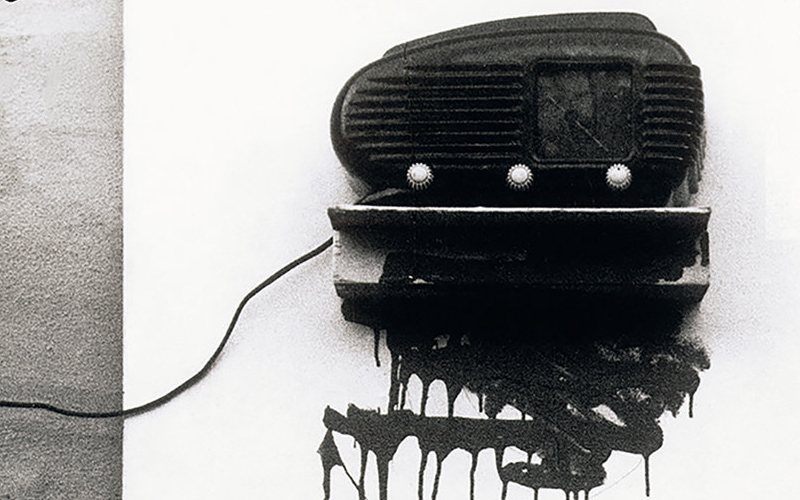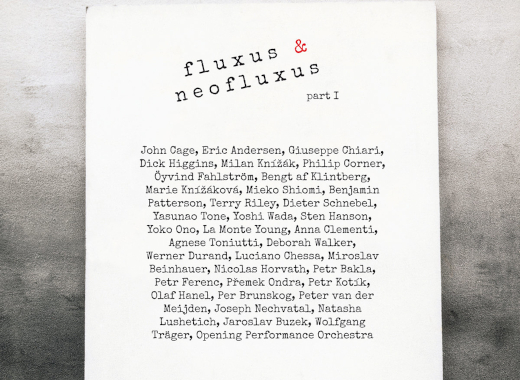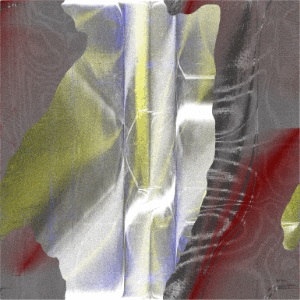Perhaps what is most astonishing about the flux of noise, beauty, sound, art, collected here is the number of recent recordings from 2018 and 2021. That makes this particular double-album of various artists unique. The other recordings that aren’t new, are rare, or at least difficult to get a hold of. Having them all in one place is a real treat.

Aesthetic and intellectual stimulation worthy of repeated listening and attentive reading
The main definition of the Fluxus art phenomena that emerged in the 1960s is that it is hard to define. Fluxus was as international as it was interdisciplinary, as inclusive of all forms of artistic media as it was mostly exclusive to conventional approaches to art making. Those who got caught up in the Fluxus seemed to have a playful attitude towards their activities, even when those actions were done with rigor. Fluxus artists encouraged audience participation, and their intermedia works were often interactive.
George Maciunas was one of the leading instigators of this anti-movement, and he described it as “a fusion of Spike Jones, gags, games, Vaudeville, Cage and Duchamp.” Yet others who worked under its broad, variegated and multicolored umbrella had different ideas of what it was. Together they could all still make Fluxus. The word itself comes from Latin and means flowing. On this compilation of Fluxus, the different sound-worlds imagined by each Fluxist and their interpreters all flow together, as if they had come from the same headwaters, even as they diverge down their own branching streams, returning to join up once again before flowing back out to sea.
Fluxus sought the recombination of the separated arts in a manner similar to the way Richard Wagner had sought to recombine them in his idea of the Gesamkunstwerk, or “total art work.” Their approaches to that end may have differed vastly, but this found Fluxists working in an expanded sphere of operation. Decompartmentalization was one of the many names of the many tricksy games they played. And it wasn’t just the rift of historic separation in the arts they wanted to mend, but separation between life and art itself.
George Brecht wrote that “In fluxus there has never been any attempt to agree on aims or methods; individuals with something unnameable in common have simply naturally coalesced to publish and perform their work. Perhaps this common something is a feeling that the bounds of art are much wider than they have conventionally seemed, or that art and certain long-established bounds are no longer very useful.”
Music was one of the areas they seeded with their malleable ideas, and some of the most revered composers of the avant-garde have been associated with the milieu. La Monte Young and Terry Riley were among the minimalist luminaries who associated with Fluxus folk during the early part of their careers. The work of Henry Flynt is sadly not included on this release, but there is a piece by Young written for Flynt instead. Yoshi Wada and other drone masters were also present. Yoko Ono is perhaps the most well known Fluxist in popular culture.
Many of the people involved in Fluxus music had some connection or other to John Cage. A number of luminaries such as Dick Higgins had taken his class at the New School for Social Research in the heart of American bohemia, the Greenwich Village, just as it was being populated by beats, burnouts and freakniks in the late fifties and early sixties. Among these were Yoko Ono and her then-husband Toshi Ichiyangi.
Such a glitch seems somehow inevitable ::
All of these artists (minus the missing Flynt) and many others are now locked into the grooves on this record, sealed into its wax. It remains preserved as a sonic document, fit for an archive, unchanged by the hands of time—until someone slashes the arm of the needle across the record. With Fluxus such a glitch seems somehow inevitable. The noise that results from the frailty of the object will become part of the composition.
Perhaps what is most astonishing about the flux of noise, beauty, sound, art, collected here is the number of recent recordings from 2018 and 2021. That makes this particular double-album of various artists unique. The other recordings that aren’t new, are rare, or at least difficult to get a hold of. Having them all in one place is a real treat.
Riley’s repetitive mantric “Shoganigidi #1” by Terry Riley from 2021 was one of the newly composed pieces used on this release and played by Miroslav Beinhauer on the broken piano it was presumably composed for. It receives its premiere here, and minimal piano has never sounded better than when played on piano that has been prepared by being broken. This gives it a particular percussive sensibility. An oscillator piece by Riley from 1962 is also featured here. Philip Corner’s “A Lovely Piece Made for & By Agnese” is another new one from 2019 and played by Agnese Toniutti. Single tones are allowed to reverberate in space with periods of silence between them punctuated only by small acts of percussion. Philip Corner’s piece “Toy Piano” from 2012 gets a performance by Toniutti also, and it sounds like a prepared piano in the way the percussion aspect of the instrument is emphasized. There is a lot of that throughout: toy pianos and broken pianos.
Perhaps all these broken pianos go back to the famous Fluxus music piece played by Joseph Beuys where he writes how he “played the piano all over – not just the keys – with many pairs of old shoes until it disintegrated. My intention was neither destructive nor nihilistic. “Heal like with like” – similia similibus curantur – in the homeopathic sense. The main intention was to indicate a new beginning.. ..or simply a revolutionary act.” I don’t know if a recording of that exists or not, but it isn’t on here, but that doesn’t mean it can’t be imagined, and that’s influence is not still felt.
The piece by Dick Higgins, titled “Emmett William’s Ear” composed in 1977 for piano, and again played by Toniutti, has become a favorite of mine from this collection. It is a rippling and undulating work of piano fit to be played in any chamber, concert hall or someone’s loft apartment.
Yasuano Tone’s clapping piece shows off the rhythmic capabilities of something very common to our human experience, but the patterns as performed, help us hear the sound of hand hitting hand, and in an ensemble, in a new way.
Mieko Shiomi’s “Direction music for a pianist” is played and spoken interspersing poetic phrases with piano phrases.
Spoken word is also present, as air formal sound works such as Benjamin Patterson’s “Paper Piece” featuring the sounds of a piece or pieces of paper being crumpled and variously manipulated.
Fixated within the Flux ::
The name for the album, Stolen Symphony, comes from an electronic piece played by Open Performance Orchestra. The last side of the double album is taken up by this 21-minute work. It is a wonderful schwobulating voyage into the further realms of avant-audio. This is the kind of stuff that should be played on the radio all the time. It seems to draw from many disciplines of avant-garde music, most notably musique concrète and sound collage, but with violin, piano, and voice along for the ride to accompany the telephone sounds, the bell sounds, the clangs, the many bits that are unidentifiable. Like much other Fluxus it remains unclassifiable. This is the noisiest and most unhinged the record gets (and it’s a lot of fun). Planes and what sounds like ice cream truck music join together in duet around the twelve minute mark of the piece. As they sidle around each other, glockenspiel or something similar is rattled about just as an underlying harmonium type drone is revealed. The voices that appear and disappear remind me of the sound-poetry advocated by those who flirted or were fixated within the Flux. It winds down with a full frontal assault along with downshifted voices whose rumbling slowed down pitch contrasts with the clatter. Finally a recognizable voice comes on to announce “well, what is going on?” before going into intermedia poetry about “Indonesian donuts on the lam” among other things. All of this is to remind us that this is carnival music for the carnival of life. It ends, oddly enough, with rock and roll rhythm guitar licks that add a sense of the familiar to what has been a trip through a strange terrain.
This ensemble were also the instigators of this comp, recording new versions of old compositions and doing the footwork to get it all together. With 31 tracks, it must have been a massive undertaking. To these the collection is rounded out by essays from Milan Knizak, Joseph Nechtaval, Per Brunskog, Olaf Hanel, Natash Lutevich, Eric Andersen and Peter Van De Meidjen. Combined together all of this provides a nice dose of aesthetic and intellectual stimulation worthy of repeated listening and attentive reading.
Fluxus & NeoFluxus / Stolen Symphony (Vol. 1) is available on Sub Rosa and was released released October 6, 2022. [Bandcamp]





















![Luke’s Anger :: Ceiling Walker EP (Love Love) — [concise]](https://igloomag.com/wp/wp-content/uploads/2025/04/lukes-anger-ceiling-walker-vinyl_feat-75x75.jpg)

![Ndorfik & madebyitself :: Solos EP (People Can Listen) — [concise]](https://igloomag.com/wp/wp-content/uploads/2025/04/ndorfik-madebyitself-solos_feat-75x75.jpg)




